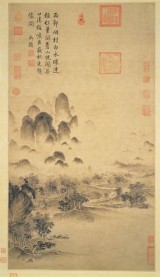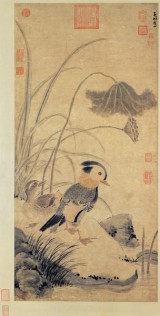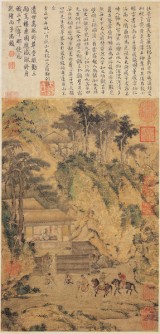TELDAP Collections
| The Art and Aesthetics of Form: Selections from the History of Chinese Painting |
|
Introduction The history of Chinese painting can be compared to a symphony. The styles and traditions in figure, landscape, and bird-and-flower painting have formed themes that continue to blend to this day into a single piece of music. Painters through the ages have made up this "orchestra," composing and performing many movements and variations within this tradition. It was from the Six Dynasties (222-589) to the Tang dynasty (618-907) that the foundations of figure painting were gradually established by such major artists as Gu Kaizhi and Wu Daozi. Modes of landscape painting then took shape in the Five Dynasties period (907-960) with variations based on geographic distinctions. For example, Jing Hao and Guan Tong depicted the drier and monumental peaks to the north while Dong Yuan and Juran represented the lush and rolling hills to the south in Jiangnan. In bird-and-flower painting, the noble Tang court manner was passed down in Sichuan through Huang Quan's style, which contrasts with that of Xu Xi in the Jiangnan area. In the Song dynasty (960-1279), landscape painters such as Fan Kuan, Guo Xi, and Li Tang created new manners based on previous traditions. The transition in compositional arrangement from grand mountains to intimate scenery also reflected in part the political, cultural, and economic shift to the south. Guided by the taste of the emperor, painters at the court academy focused on observing nature combined with "poetic sentiment" to reinforce the expression of both subject and artist. Painters were also inspired by things around them, leading even to the depiction of technical and architectural elements in the late eleventh century. The focus on poetic sentiment led to the combination of painting, poetry, and calligraphy (the "Three Perfections") in the same work (often as an album leaf or fan) by the Southern Song (1127-1279). Scholars earlier in the Northern Song (960-1126) thought that painting as an art had to go beyond just the "appearance of forms" in order to express the ideas and cultivation of the artist. This became the foundation of the movement known as literati (scholar) painting. The goal of literati painters in the Yuan dynasty (1279-1368), including Zhao Mengfu and the Four Yuan Masters (Huang Gongwang, Wu Zhen, Ni Zan, and Wang Meng), was in part to revive the antiquity of the Tang and Northern Song as a starting point for personal expression. This variation on revivalism transformed these old "melodies" into new and personal tunes, some of which gradually developed into important traditions of their own in the Ming and Qing dynasties. As in poetry and calligraphy, the focus on personal cultivation became an integral part of expression in painting. Starting from the Ming dynasty (1368-1644), painting often became distinguished into local schools that formed important clusters in the history of art. The styles of "Wu School" artists in the Suzhou area, for example, were based on the cultivated approaches of scholar painting by the Four Yuan Masters. The "Zhe School" consisted mostly of painters from the Zhejiang and Fujian areas; also active at court, they created a direct and liberated manner of monochrome ink painting based on Southern Song models. The late Ming master Dong Qichang from Songjiang and the Four Wangs (Wang Shimin, Wang Jian, Wang Hui, and Wang Yuanqi) of the early Qing dynasty (1644-1911) adopted the lofty literati goal of unifying certain ancient styles into a "grand synthesis" so that all in mind and nature could be rendered with brush and ink. The result was the vastly influential "Orthodox School," which was supported by the Manchu Qing emperors. The court also took an interest in Western painting techniques (brought by European missionaries) that involved volume and perspective, which became known to and used by some Chinese painters to create a fused style. Outside the court, the major commercial city of Yangzhou developed the trend toward individualism to become a center for "eccentric" yet professional painters. It also spread to Shanghai, where the styles of artists were also inspired by "non-orthodox" manners, which themselves became models for later artists. Thus, throughout the ages, a hallmark of Chinese painting has been the pursuit of individuality and innovation within the framework of one's "symphonic" heritage. This exhibition represents a selection of individual "performances" from the Museum collection arranged in chronological order in order to provide an overview of some major traditions and movements in Chinese painting.
Selections
Huizong, the eighth emperor of the Northern Song, specialized in painting (bird-and-flower subjects in particular) and also was gifted at poetry and calligraphy, together known as the Three Perfections. In his reign, he reformed the Painting Academy, and three catalogues were compiled for the imperial collection of painting, calligraphy, and antiquities, setting a precedent for later records of such. In this work, lofty mountains rise in the left background with shoals and trees in front. The outlines of the peaks are rounded with mists and waters appearing here and there among light ink washes, creating a lyrical atmosphere in the landscape. Though this work features a Huizong cipher and his "Imperial calligraphy" seal, the style suggests it was done sometime in the Southern Song.
Wang Meng was a native of Wuxing (modern Huzhou, Zhejiang). A grandson of Zhao Mengfu, he also was taught by Huang Gongwang while learning from such figures as Ni Zan. He also stood on his own, becoming one of the Four Yuan Masters. This work from 1343 depicts the banks of a river, where reeds grow and a boat drifts. Trees intersect and in the fore- and middleground are buildings with ridges going up and into the distance. The piling of mountains and waters creates a dense and complex composition, the tangled texture strokes expressing the lushness of forests and land. The light and elegant brush and ink with exceptionally refined colors give bright clarity to the archaic heaviness, making this a masterpiece of Wang Meng's painting.
Zhang Zhong (style name Zizheng) was native to Songjiang in Jiangsu. He excelled at birds-and-flowers and ink play. This work depicts the corner of a lotus pond in late autumn. A pair of waterfowl similar to mandarin ducks rests on the shore. The majestic male appears with a female crouched on the ground behind. Cattails bend in the breeze with a couple stems of withered lotus. Reflections and forms appear on and under the water. The artist used strong brushwork to outline the cattails and lotus stalks, the coloring having an elegantly light touch worthy of it as "the best 'sketching from life' of the Yuan." The inscription originally probably read, "Made by Zizheng for So-and-so," but after remounting only "Made by Zizheng for…" remains.
Imitating Zhao Bosu's Illustration of the Latter Red Cliff Wen Zhengming, a native of Changzhou (modern Suzhou), learned painting from Shen Zhou, tracing his style back to the Yuan dynasty and becoming one of the Four Ming Masters. This work from 1548 is based on Su Shi's "Latter Ode on the Red Cliff." It is done in light blue-and-green, similar to the literati blue-and-green mode of the Yuan artist Zhao Mengfu, while the structure and piling of mountains and tree branches and leaves reveal Wen's own style. Wen Jia's colophon at the end says the original by Zhao Bosu belonged to a Suzhou scholar. An official wanted it for Grand Secretary Yan Song's son, but the owner was unwilling to part with it. As a result, Wen Zhengming encouraged his friend not to anger such a high official and did this imitation for him.
This work illustrates the late Han dynasty story of Liu Bei inviting Zhuge Liang out of reclusion. In a thatched cottage nestled among pines and bamboo sits Zhuge on a daybed deep in thought. Outside the fence are Liu Bei, Guan Yu, and Zhang Fei on horseback with attendants. The spears and halberds behind the upper right hills suggest a large army waiting. The brushwork is light and elegant, but the mountains appear to be a later addition. With no seal or signature, the old attribution is to Dong Zhan. Based on style, though, it appears to be a later imitation from the early Ming. Dong Zhan (style name Boren) was native to Ru’nan (modern Ru’nan, Henan). He served as Guanglu Grand Master in the Sui-Tang period and was equally renowned as Zhan Ziqian.
The Five Planets and 28 Constellations Ding Guanpeng, a native of Shuntian (modern Beijing), served in the Painting Academy at court in 1726, specializing in figures as well as Buddhist and Taoist subjects. This work is Ding's version after the Qing Painting Academy's copy of a handscroll of deities for the Five Planets and 28 Constellations by Zhang Sengyu. The ancient Chinese named the five major planets after the Five Elements of metal, wood, water, fire, and earth, representing the Yellow and Celestial Lines used to demarcate the Four Palaces of the East, North, West, and South. Each has seven residences for a total of 28. The planets and constellations here are personified as deities, figures, or in animal-headed form, each accompanied by an inscription for its planet or constellation name.
Text and images are provided by National Palace Museum Сначала я принял было парнишку "Мультфильмы волк и теленок скачать"за коробейника, но уж больно у него хорошие манеры, да и короба "Скачать музыку слепаков семен"за спиной нет. Я продолжал хохотать и после того, как он "Скачать чит вх для ксс"отпустил свою жертву и вскочил на ноги; я смеялся так громко, что не "Русский готический шрифт скачать"расслышал ругательств и угроз, которыми он осыпал меня в ответ. По-видимому, и всадник думал так "Скачать артмани новое"же, потому что он не натянул поводья "Скачать программу для записи дисков nero"и не остановил ее; предоставленная самой себе, "Скачать почта мазила"она умчалась в прерию. Когда ему сказали, что тот уехал, и объяснили, в какую сторону и когда, "Клип детских песен скачать"молодой Пойндекстер быстро поскакал в указанном направлении, как бы намереваясь догнать мустангера. Пальчики оближешь-самый чистокровный! Я "Школе музыка скачать"не могу передать вам, какое унижение "Скачать плеер читает все форматы"испытывали все, кто был на борту ``Красавицы''.
|


























